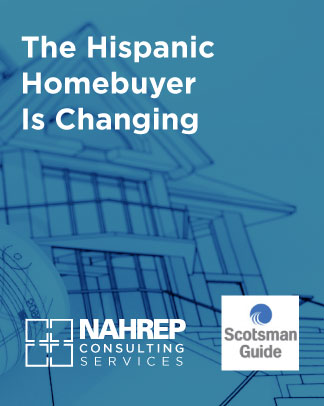Hispanic households represent a growing opportunity to expand your market footprint
The first few months of the new year offer a fresh start for most of us. The first quarter presents opportunities to get things accomplished as a mortgage originator that you didn’t get to last year, but vowed you would pursue in the year ahead.
New opportunities are always a good thing, but we still have limited resources. The resources that are the most scarce are usually time, money and people.
With finite resources, we have to choose our activities, including business-development initiatives, wisely. What will be worth the investment of these resources for the best pay off in the long run? This question is important to answer before choosing where to focus your business-development activities in 2018.
What business-development opportunity offers all of these factors? The answer: the minority homebuyer market. If your 2018 business strategy isn’t inclusive of diverse markets, you are missing a huge growth opportunity.
A large, hot market
According to a December 2016 report from the Harvard University Joint Center for Housing Studies, the share of household growth in the U.S. accounted for by minorities will jump from 72 percent between 2015 and 2025 to over 90 percent between 2025-2035.
In an environment where refinances are pointing downward, mortgage originators must seek opportunities where they can make up for lost revenue lines. Since the Great Recession, we have seen some strong recovery, but the nation’s overall homeownership rate declined to 63.4 percent in 2016, which was a 51-year low.
Comparatively, however, the Latino market was the only segment to increase its homeownership rate between 2015 and 2016, from 45.6 percent to 46 percent.
Rising income
Diverse markets are many times seen as the “LMI,” or low- and moderate-income segment, but that is a narrow and short-sighted view. Although many minority groups are still working hard to fill the gap between their income and the income levels in the overall market, there has been a great deal of progress made.
In fact, Hispanic-household annual median real incomes rose by 6.1 percent in 2015, according to a U.S. Census Bureau study. That was the largest gain among all population groups, which also helped to roll back poverty levels. Median income for Hispanic households jumped again in 2016, by 4.3 percent, Census Bureau figures show.
It’s likely we will continue to see these data points trend positively so long as Latinos continue to drive the growth in the nation’s workforce. Between 2010 and 2016, Hispanics accounted for 76.4 percent of the growth in the U.S. labor force. That’s three out of four new workers added to the U.S. economy.
Plenty of optimism
As part of an overall effort to support the housing market, Fannie Mae gathers attitudinal feedback from consumers. Its National Housing Survey conducted between October and November of 2016 found that Hispanics continue to hold an optimistic economic outlook on their personal financial situations and also feel it’s a good time to buy a home.
Hispanics continue to overwhelmingly prefer homeownership to renting, with some nine out of 10 Hispanics indicating in the Fannie Mae survey that in the future they are more likely to own a home than rent. Of those Hispanics who already own a home, 90 percent indicated they are satisfied with the features of their existing mortgage.
Also, due to the nature of the Latino family structure — with many living in extendedhousehold situations — the likelihood that mortgage originators will receive referrals from multiple members or generations of one household is high.
The next move
With these important factors to consider, why wouldn’t your 2018 business-development activities include, if not revolve around, diverse markets as a key driver for your business? If you are convinced, or at least intrigued, then how can you begin the process of tapping into this opportunity?
First of all, don’t go translating everything in your marketing library. That’s a nice intent, but you would be missing the forest for the trees. Take a more strategic view of the segment and take inventory of what you know and what you need to know.
- Become involved in diverse markets. There are many reputable organizations that were created to help increase sustainable homeownership within diverse markets. The National Association of Hispanic Real Estate Professionals, The Asian Real Estate Association of America and National Association of Real Estate Brokers are good examples.
- Create strong relationships. Seek out other organizations that understand these diverse market segments. Those sources can include housing-finance agencies, credit-counseling services, economic development councils and other professional networks — the Hispanic Chamber of Commerce, for example.
- Tap into your own resources. Employee Resource Groups (ERGs) and other types of business-networking groups are excellent places from which to draw talent, ideas and thought leadership. ERGs can tell you where to look for more talent, or give you opinions on your current product offerings. You may even identify future or underutilized talent. Your ERG can be a great focus group and even help guide whether or not you should translate or create
any language materials.
Of course, you also should seek assistance from consultants and mentors who can guide your activities to ensure you are moving toward a profitable and sustainable long-term strategy.







